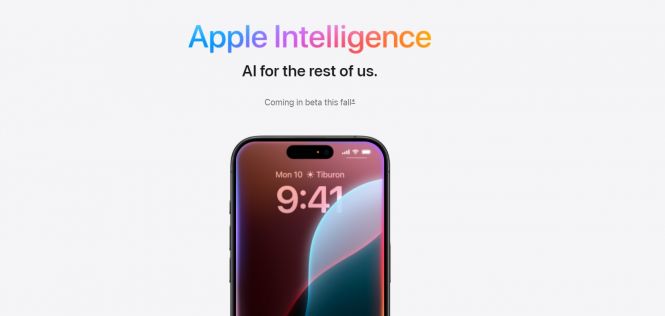 Apple Intelligence: what's known so far (June 2024)
Apple Intelligence: what's known so far (June 2024)
AI has been the centerpiece of the recent WWDC 2024. One way or another, pretty much everything announced and highlighted at the conference, arguably, revolved around the latest artificial intelligence tech.
One single item, though, deserves special attention: Apple Intelligence. The one-liner for this feature – or a whole underlying infrastructure, as it seems – is “AI for the rest of us.” Let’s take a look at what is known about this meta-product so far.
Write, express, and get things done
This is sort of a second one-liner for Apple Intelligence. The respective features are described on the dedicated preview page, which also tells you several times about personal context, meaning that Apple’s AI will have access to everything on your device. Not to worry, though: the company insists your personal data is safe and secure, and will not be uploaded anywhere.
Below, we logically outline what can really be handy in everyday life without marketing seasonings.
Write
All of us write nowadays, right? Texting is writing, too, so, in this regard, the first one-liner applies 100%. Apple plans to introduce Writing Tools that will be powered by Apple Intelligence, enabling quick summarization, proofreading, and rewriting of your texts until they’re perfect.
In Mail, Apple Intelligence will power Smart Replies, a sort of a letter builder mini app that suggests relevant chunks of text, actions, etc. based on what was in the letter you are replying to.
Express
Considering Apple’s passion for all things visual, Genmoji were destined to appear sooner or later. With Apple Intelligence behind them, these custom-made emojis are created based on your verbal input and images, if you care to add them to the mix.
Another new product is Image Playground, which looks like a prompt builder on steroids, featuring visual cues and suggestions that you can tap/click and thus add to your query that Apple Intelligence will turn into a picture.
Image Wand looks particularly promising for those who find it easier to express themselves with words AND images. The tool takes sketches, however badly executed, plus verbal cues, and turns them into realistic images.
 Best example of how to use the Clean Up tool. Snapshot from Apple website Best example of how to use the Clean Up tool. Snapshot from Apple website
Best example of how to use the Clean Up tool. Snapshot from Apple website Best example of how to use the Clean Up tool. Snapshot from Apple website
The Clean Up tool isn’t exactly about expressing yourself, but it does belong to the domain of images. This one is probably the most sought-after feature: it lets you free your pictures from anything and anyone that you don’t need there. The image on the Apple Intelligence preview page, which we snapped, is probably the best example of a Clean Up tool use case.
Get things done
With complete access to everything on your device, Apple Intelligence powers Focus, which will prioritize notifications for you, bringing to the forefront those that require attention and/or are time-sensitive. Similarly, the system will arrange the mess in your inbox and put the most important messages on top.
Siri, according to Apple, is a real superhero now. Marketing spices aside, the ability to operate across apps sounds promising, same as better natural language processing capabilities. In a perfect world, you would be able to tell Siri to do something in an app different from the one you’re currently using, and word it any way you like.
How will Apple Intelligence work?
Apple admits that its AI taps into everything on your device, but claims that all the heavy lifting happens locally, with occasional contact to Private Cloud Compute, which is thoroughly secure. It looks like it’s more about hardware than software, an assumption further backed by the fact that Apple Intelligence will only be available to the proud owners of iPhone 15 Pro/Pro Max or newer, M1-powered iPads (or newer), and M1-powered Macs (or newer, of course).
ChatGPT will be integrated seamlessly, but not used all the time. It’ll be contacted for assistance in certain cases, when your request to Siri is best processed with the help of OpenAI’s product. Apple claims that users will have control over how ChatGPT is used.
Should we be worried?
The feature, or system, or infrastructure, whatever you wish to call it, goes online in fall 2024 only, but words of caution have already been voiced. As mentioned above, Apple claims most things will be processed locally, but most is not all. This means that explicitly some data of personal and private nature will be sent to Apple’s servers. Implicitly, the stream of data will likely have vague boundaries, i.e., you’ll have only rudimentary control over it.
There will likely be ways to set limits to the omnipresent AI in your device. Apple definitely understands that full-scale rollout of the new system will entail a spree of litigation on all levels, from individual users through class action to a court battle between corporations. Still, the company proceeds, which can mean two things: first, the user agreement wording is flawless, and second, the reward is worth the risk. Realizing that Apple is a for-profit business, and personal data is a valuable asset, the latter can trigger an alarm in worrisome minds. As for the rest of us, those who stopped believing in privacy quite some time ago, Apple Intelligence looks like a Swiss Army knife with a couple tools that will really be handy on a daily basis and a burden of sundry instruments resorted to irregularly or never. Still, a nice deal!



